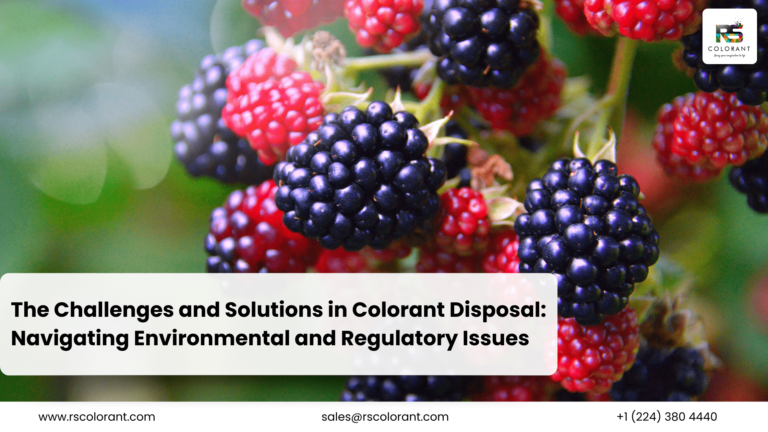The Health Impacts of Synthetic vs. Natural Colorants
In today’s world, colorants play a vital role in various industries, from food and cosmetics to textiles and pharmaceuticals. As consumers become more health-conscious, there’s a growing debate about the safety and health implications of synthetic versus natural colorants. This article delves into the health impacts of these two types of colorants, providing a comprehensive comparison backed by industry statistics and expert insights.
Introduction
Colorants are substances used to impart color to products, making them more appealing and marketable. They are broadly classified into two categories: synthetic and natural colorants. Synthetic colorants are man-made chemicals, while natural colorants are derived from natural sources such as plants, minerals, and animals. Understanding the health impacts of these colorants is crucial for making informed choices as a consumer or industry professional.
Understanding Synthetic Colorants
Synthetic colorants, also known as artificial colorants, are produced through chemical processes. They are widely used due to their bright colors, consistency, and cost-effectiveness. Common synthetic colorants include:
- Tartrazine (Yellow 5)
- Allura Red (Red 40)
- Sunset Yellow (Yellow 6)
- Brilliant Blue (Blue 1)
Health Concerns Associated with Synthetic Colorants
Despite their widespread use, synthetic colorants have been linked to various health concerns. Some of the key issues include:
- Allergic Reactions: Synthetic colorants can trigger allergic reactions in some individuals, leading to symptoms such as hives, itching, and asthma.
- Hyperactivity in Children: Studies have suggested a link between synthetic colorants and hyperactivity in children, prompting regulatory bodies to impose stricter guidelines.
- Carcinogenic Potential: Certain synthetic colorants have been classified as potential carcinogens, raising concerns about their long-term health effects.
- Toxicity: Prolonged exposure to synthetic colorants has been associated with toxicity in vital organs, including the liver and kidneys.
Regulatory Measures
Regulatory agencies such as the U.S. Food and Drug Administration (FDA) and the European Food Safety Authority (EFSA) have established guidelines and permissible limits for the use of synthetic colorants. These measures aim to minimize health risks while ensuring consumer safety.
Understanding Natural Colorants
Natural colorants are derived from natural sources and are perceived as safer alternatives to synthetic colorants. Common natural colorants include:
- Carotenoids (e.g., Beta-Carotene)
- Anthocyanins (e.g., Red Cabbage)
- Chlorophyll (e.g., Spinach)
- Curcumin (e.g., Turmeric)
Health Benefits of Natural Colorants
Natural colorants are often associated with health benefits due to their origin and composition. Some of the key benefits include:
- Antioxidant Properties: Many natural colorants, such as anthocyanins and carotenoids, possess antioxidant properties that help combat oxidative stress and inflammation.
- Nutritional Value: Natural colorants often contain vitamins, minerals, and other nutrients that contribute to overall health and well-being.
- Reduced Risk of Adverse Reactions: Natural colorants are less likely to cause allergic reactions and other adverse effects compared to synthetic colorants.
- Eco-Friendly: The production of natural colorants is generally more environmentally friendly, reducing the ecological footprint.
Challenges in Using Natural Colorants
Despite their benefits, natural colorants also face certain challenges, including:
- Stability: Natural colorants can be less stable than synthetic ones, leading to variations in color intensity and consistency.
- Cost: The extraction and processing of natural colorants can be more expensive, impacting the overall cost of the final product.
- Limited Color Range: Natural colorants may not provide the same vibrant and diverse color range as synthetic colorants.
Comparative Analysis: Synthetic vs. Natural Colorants
Health Impacts
Synthetic Colorants
- Potential Risks: Allergic reactions, hyperactivity, carcinogenic potential, organ toxicity.
- Regulation: Strict guidelines and permissible limits by regulatory bodies.
Natural Colorants
- Health Benefits: Antioxidant properties, nutritional value, reduced risk of adverse reactions.
- Eco-Friendliness: Generally more environmentally friendly production processes.
Industry Usage
Synthetic Colorants
- Advantages: Bright colors, consistency, cost-effectiveness.
- Challenges: Health concerns, regulatory restrictions.
Natural Colorants
- Advantages: Health benefits, eco-friendliness.
- Challenges: Stability, cost, limited color range.
Industry Statistics and Trends
The global colorants market is evolving as consumers and industries shift towards safer and more sustainable options. According to industry reports:
- The global natural colorants market is projected to grow at a CAGR of 8.8% from 2021 to 2026, driven by increasing consumer demand for clean-label products and natural ingredients.
- In contrast, the synthetic colorants market is expected to grow at a slower pace, with a CAGR of 4.5% during the same period, reflecting the growing concerns about their health impacts.
Case Studies and Real-World Examples
Food Industry
The food industry has seen a significant shift towards natural colorants. For instance, major brands like Nestlé and Kellogg’s have announced plans to remove artificial colors from their products in response to consumer demand for natural ingredients.
Cosmetics Industry
The cosmetics industry is also embracing natural colorants. Brands like Lush and Burt’s Bees have gained popularity by using natural colorants in their products, promoting them as safer and more eco-friendly alternatives.
Textile Industry
In the textile industry, natural dyes are being explored as sustainable options. Companies are investing in research to develop stable and vibrant natural colorants to meet consumer preferences for eco-friendly fashion.
Conclusion
The debate between synthetic and natural colorants is ongoing, with each type having its own set of advantages and challenges. While synthetic colorants offer bright colors and cost-effectiveness, they pose health risks that cannot be ignored. On the other hand, natural colorants provide health benefits and environmental advantages but face challenges in stability and cost.
As consumers become more health-conscious and environmentally aware, the demand for natural colorants is expected to rise. Industries must navigate these trends by balancing safety, sustainability, and economic considerations to meet consumer expectations and regulatory requirements.




